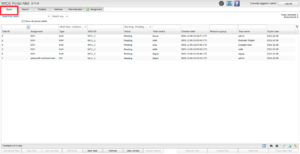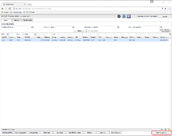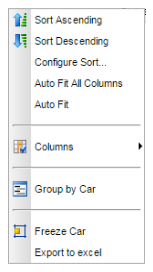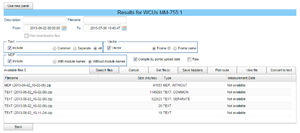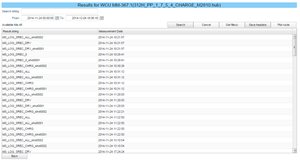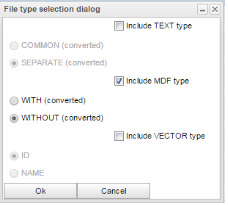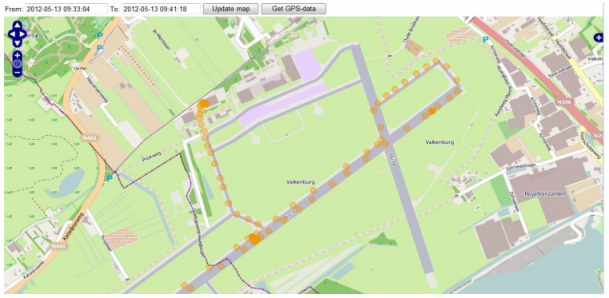Tasks Tab
You can easily search among all tasks on the portal by selecting this tab. There are two sections in this panel. The top one deals with various search criteria while the bottom one shows
search results.
Each search criteria affects what is indicated by the label associated with the text field. As an
example you have the label “Task ID:” which searches the field for task IDs to find matching
tasks to display.
In version 2.40 and above you can use regular expressions in all search fields. To designate an "all" search you enter a period (".") for that particular field. All searches are treated with the letters as wild-cards. An example is if you intend to search for tasks containing the word “bear” simply enter “bear” in the text field. Now, if there are tasks with the names “bear”, “polar bear”and “unbearable” all of these will match as they
contain the word “bear” somewhere.
If you enter characters in more than one text field, they will be treated with a logical AND between each field when searching.
To search for a range of WCUs, assume the WCUs MM-810:1 – MM-823:1, you enter the query 8[1][0-9]|8[2][0-3].
This is a regular expression where the first expression, 8[1][0-9], means that we want our search to start with an '8' followed by a '1' and then any digit in range 0-9.
The second part, 8[2][0-3], means an '8' followed by a '2' and then any digit in range 0-3. The two expressions are combined with a pipe characater ("|") which means logical OR.
In other words we are looking for range 810-819 OR 820-823.
Note! If your WCU/resource group you are searching for has special characters (like '(' or '/') in its name you may need to escape these characters in order to get the desired result. Escape means putting a '\' before the special character. For example if you want to enter (and search for) the resource group name 'ABC(Alpha_Bravo_Charlie)' you need to write 'ABC\(Alpha\_Bravo\_Charlie\)'. Another example is when you want to list a WCU that contains "07-51" in its name. In this case you need to type "07\-51", otherwise the "-" character will make the searcher to search for a range of numbers.
For more info how to use regular expressions, see Regular Expressions
The search tab shows all assignments the current logged in user has read access to. If the user also has write access to the assignments it is possible to stop a running assignment. To stop a running assignment, select the assigment and click the "Stop assignment" button located in the bottom right corner of the search tab. This button is marked with read in illustration 14b.
The Search Fields Section
Above most columns of the table there is a field that can be used to enter search criteria to find assignments. Most of the fields are straight forward in where they apply. However some of them needs some more explaining. Fields where you need to supply a date can be done in two ways. By clicking on the small calendar picture to the right of the field brings up calendar where you can select a date. When selecting a date this way, the time portion is always set to 12:00:00. Edit this afterwards to fit your needs. You can also enter a date by in the field and the accepted form is: yyyy-MM-dd HH:mm:ss.
The “Assignment status” field is made up of check boxes. If you leave all unchecked, it is implied that you do not care which status the assignment is in and therefore all statuses are included in the search. As soon as you check one or more of these a logical or is applied to the selection of statuses. The “Last update from” and to option relates to when the assignment changed its status, i.e. any of the status from the check boxes. There is an option to filter by the type of assignment using the check boxes to the right of “Assignment type:”. In the “Current hit count” you can see how many hits you will receive if you decide to get the search results. This is a good indicator to see if you should narrow your search criteria. To sort the table you click the column header either by clicking the arrow to the right of each header to select ordering, each click on the header somewhere else will toggle ascending/descending sorting or you can right click on the header to call up the header menu where you can select sorting order or which columns you would like to see.
The Results Section
The results are fetched when you press Enter or when you press the "Search" button to the right in the Search tab. In order to view a result you simply select the assignment in the table that you are interested in. Depending on the assignment different buttons will be enabled. If there are results available the “Get Result Files” button will be enabled. Multiple rows in the table can be selected by holding down the shift key in order to select a range of rows or by holding down the ctrl-key to select individual rows.
If you right-click an entry you will be presented with a pop-up with a range of possibilities. Firstly, all the functionality of the buttons above the search result table is there along with a few more that are related to getting information. There is also some context awareness of this pop-up. An example of that is if you right-click in the WCU column, the option of showing the WCU information will be visible. If you instead right-click “Car” column, showing the cars information is visible. The reason for this is to keep the number of options to a minimum in order not to clobber your view. The “Task ID” column has an extra entry saying “Get result files” that brings up a dialog to download result files for a task. An explanation of this functionality can be found at the end of Active Tasks Tab#General Tab Layout.
There is an option to save which columns you are interested in to see. By clicking on the button “Save headers” the currently shown columns are saved and restored when you log in the next time. Right-clicking in the header will bring up menu where you can among other things select which columns should be visible in the table of results. The order of the columns can also be change by simply dragging a column to a new position. When saving the set of columns, the order of them is also saved on the server. The drop down menu of the table header is in Illustration 16. The current table can be exported to an excel sheet by selecting “Export to excel”.
The Result Files and Logs Dialog
An assignment can generate in principle an infinite number of result files. To be able to work with the files, a search window will open when you press the “Get Result Files” button or the “Get Log Files” button. There is only a minor difference in that when you hit the “Get Log Files” button not all search terms are available. See Illustration 17 below.
At the top we have some information regarding the task such as the ID and description. Next is a field to hide the search field to make room for the table with the list of files. There are 4 different kinds of search criteria you use to filter out the result files you are interested in: the date, file name, the size of the file and the type of file. As you type your different criteria in the search fields, the “Available files:” entry reflects the number of files that would be listed if you hit the “Search Files” button. Depending on the type of assignment you will be presented with a potentially differing set of buttons and controls. In the illustration above an MCD-Hub assignment was selected. To choose the subtype for a file, use the radio buttons for each of the types MDF, Vector and Text. The subtype selection is only enabled if the corresponding file type is checked.
The check box “Compile by upload date” groups together all results from each result upload from the WCU. This is very useful as one upload can contain thousands of files and you are mostly interested in all of them to gather statistics or analyzing the result. When you are satisfied with your search criteria, hit the Search Files button to view the list of files. An example of such a list is in Illustration 18 below. To select a file, click the row with the file you are interested in and it will be selected. By holding the shift-key down when you click an entry, all entries between the previous click and this one will be selected. To select a set of individual files, hold down the ctrl-key while selecting entries. When you push the Get File(s) button, a save file dialog opens where you can save the zip-file with your selected files zipped together.
On the right you have a set or four buttons. The top one has already been described and is straight forward as it downloads result files to your computer. The next “Save header” saves which columns your are interested in seeing. The third button is used to get a plot of where the car has been during the collection of data for the selected file. If the data series is long, the last 24 hours are used to plot the route. The fourth button, “View file” is also only used for text files (and log files) which opens up a simple text area window where you can view the contents of the file. You can also double click a text file entry to view the contents of a file. The fifth button is only visible for MCD-Hub assignments and it is used to convert files in MDF format to text format. When you are done, just hit the Back button and the window will disappear.
From version 2.42 it is also possible to include gpx-files together with the downloaded result files by having the "Include gpx files" checkbox checked. Currently this is set by default.
For each included result file, there will be a corresponding gpx file with the same filename as the result file. The gpx file will contain the route when the assignment was executed. Note that not all assignments have an end date, so in this case, the end date is set to 24h from the start date.
Downloading Files
Depending on the number of files and sizes of the result files, it can take a considerable time to zip the files together before they are ready for download. Therefore, files are zipped and getting ready in the background on the server and when they are ready for download you will be notified with a toast message at the top next to the download dialog icon. The icon can be found in the tool strip at the top depicted in Illustration 19 below.
When you press the “Get files(s)” button you will have the option of adding a description to the download which you can later see in the “My downloads” dialog for identification. Here you can also choose to insert VIN and plate number in all downloaded files. You can read more about hit here: Filenames when downloading. It is optional and you don't have to do that.
The following toast will be shown when the preparation begins.
When the preparation is done and your files are ready for download, the following toast will be shown in conjunction with the download icon in the tool strip.
To see what preparations are ready for download, click the download icon in the tool strip, a dialog called “My Downloads” will open. If a download is being prepared, the progress bar in the column “Progress” will fill gradually fill with green until it is ready. If you are downloading a file, the progress bar Download progress will gradually fill with green until it is done. If you entered a description for your preparation, it will show in the column “Description”. To download a file click the icon with a down pointing arrow. You will be prompted for an optional name of the downloaded file. Whatever you type there will automatically get the file extension “.zip”. To close the dialog, click the cross in the upper right corner of the dialog.
My Downloads Dialog
Whether it's zipped result files or converted text files, downloading them to your local computer is done via this dialog. Each row in the table corresponds to a file to download.
When you have decided to download some result files, a zipping process starts at the server. This process can take quite some time if the result files are large. If you change your mind and decide that you are not interested in the files currently getting zipped, you can choose to interrupt the file zipping process. This is done via the "cancel" icon that appears to the right in the "My downloads" dialog. See Figure "Cancel Download Process" for an example.
You can also choose to cancel an ongoing download this way. If the file zipping process was cancelled, the background colour of this row till change to red. This means that the file can not be downloaded and the column "Status" will display the reason. An example of this can be seen in Figure "Download Cancelled".
When you have downloaded or cancelled a download, the record for this download will stay in "My downloads" for three days until they are automatically removed. If you want to clean remove them earlier, click the red "remove record" icon that appears to the right of each downloaded/cancelled download.
The New Results Panel
In an effort to somewhat abstract the notion that the MCD-Hub generates files, this panel has been introduced. You enter this panel by pressing the button “Use new panel” which you at the top as depicted in Illustration 17 in #The Result Files and Logs Dialog. In this panel you deal with meta data of a measurement. As an example, consider a measurement made using the assignment with the name “312H_PP_1_7_5_4_CHARGE_M2810.hub”. When the data is converted it is converted into a number of different formats, however some parts of the file name are consistent over the different formats. A result file from this assignment could be named “312H_PP_1_7_5_4_CHARGE_M2810_MS_LOG_SREC_DRV_shot0001_20141124_092157.dat”. Depending on file type it will end with .dat, .txt or .asc. In this panel the “set” of different files will be represented with only one entry namely “MS_LOG_SREC_DRV_shot0001” and a column with when the measurement was triggered. See Illustration 23 for an example. Here you can filter the result based on time and a string that matches part of the filename. Select the measurements you are interested in and press the “Get file(s)” button. You will now be presented with a selection window of which file types you are interested in. You can select as many file types as you which to download.
The file type selection dialog is as depicted in Illustration 24. In this dialog the MDF type of file is selected with the subtype without module names. After each subtype for the text and MDF type it says (converted). This means that this data is accessible right away with any need to convert the raw data into any of the formats, except for the Vector type which does not have the (converted) text for any of the subtypes. In case the file type you are interested in is not currently converted on the portal you will be given the option to start a conversion when you press the Ok button. Depending on the file type and amount of data in the measurement it can take a long time but when it is done you will get a message saying “Conversion done”.
Plot Route Dialog
If you are interested in seeing where the car was driven while making measurements you can use the “Plot route” function by either using the button or the right-click menu. Doing this will open a dialog which by default plots the last 24 hour GPS positions (maximum of 100 positions) or, if there are not any during the last 24 hours, the last 100 registered positions. The dialog is depicted in Illustration 25 below. Just above the map are two dates present, from and to. These show the time interval that is shown on the map. You can change the dates and press the “Update map” button to view a new set a GPS positions during a measurement. You can zoom in and out of the map by pressing the plus or minus signs. By pressing the left mouse button and then drag the map you can freely move the map around. To zoom in on a particular area, hold down the left shift key and the left mouse button while dragging and a red rectangle will appear showing which area will be magnified. Release the mouse button to zoom in on the area. You can download the set of positions in a file by pressing the button “Get GPS-data”. This downloads the GPS data to your computer in the gpx format to be used elsewhere.
